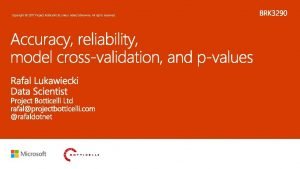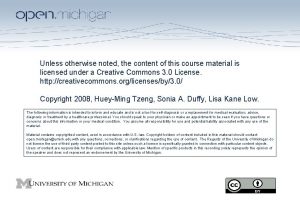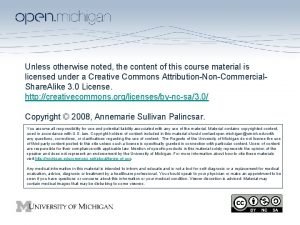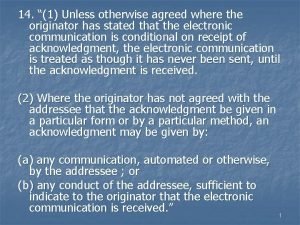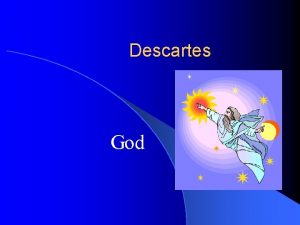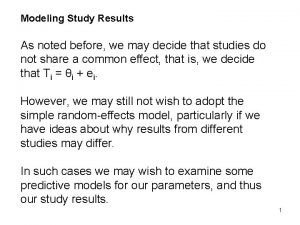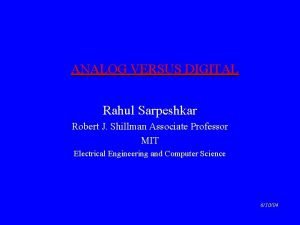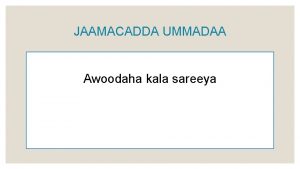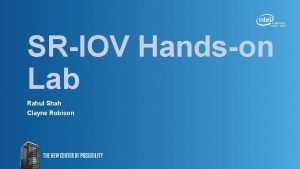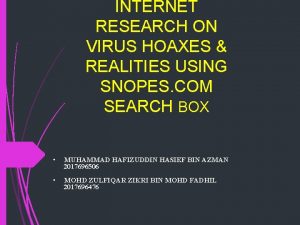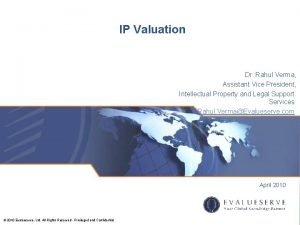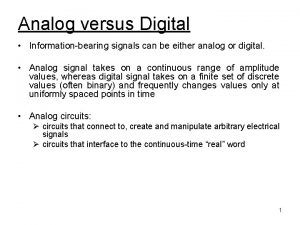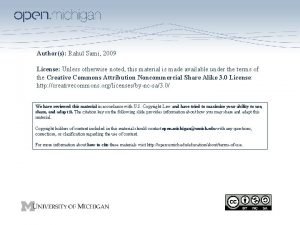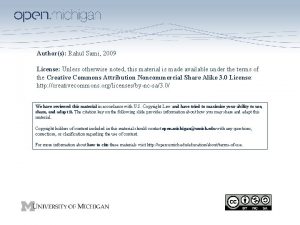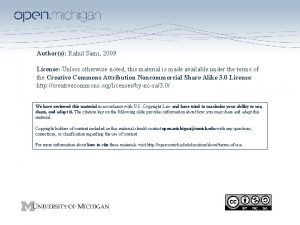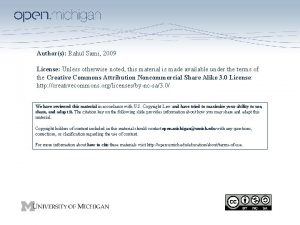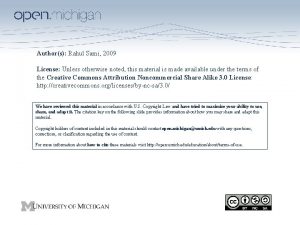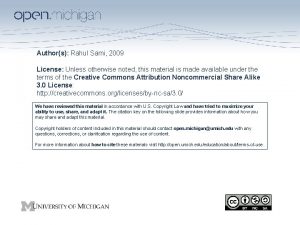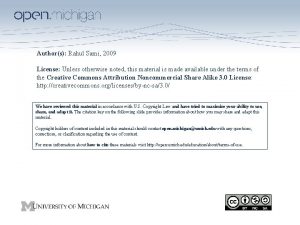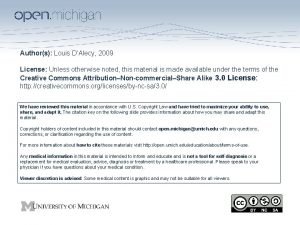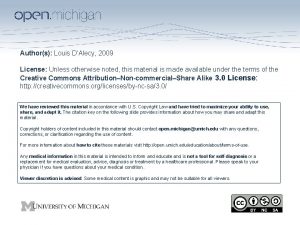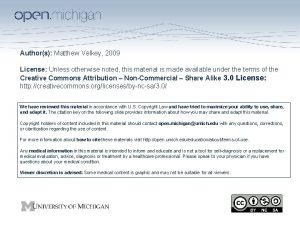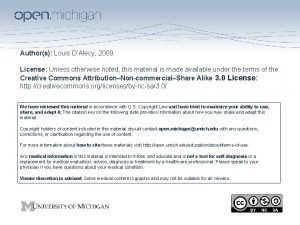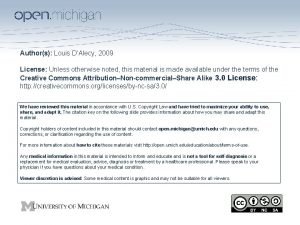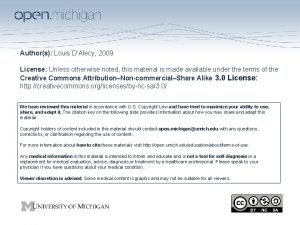Authors Rahul Sami 2009 License Unless otherwise noted



![4 Taxonomy of E-Commerce Applications [Schafer, Konstan, Riedl] n Characterize systems based on – 4 Taxonomy of E-Commerce Applications [Schafer, Konstan, Riedl] n Characterize systems based on –](https://slidetodoc.com/presentation_image_h2/986405183b35649780ea1485a3c63472/image-4.jpg)










- Slides: 14

Author(s): Rahul Sami, 2009 License: Unless otherwise noted, this material is made available under the terms of the Creative Commons Attribution Noncommercial Share Alike 3. 0 License: http: //creativecommons. org/licenses/by-nc-sa/3. 0/ We have reviewed this material in accordance with U. S. Copyright Law and have tried to maximize your ability to use, share, and adapt it. The citation key on the following slide provides information about how you may share and adapt this material. Copyright holders of content included in this material should contact open. michigan@umich. edu with any questions, corrections, or clarification regarding the use of content. For more information about how to cite these materials visit http: //open. umich. edu/education/about/terms-of-use.

Citation Key for more information see: http: //open. umich. edu/wiki/Citation. Policy Use + Share + Adapt { Content the copyright holder, author, or law permits you to use, share and adapt. } Public Domain – Government: Works that are produced by the U. S. Government. (USC 17 § 105) Public Domain – Expired: Works that are no longer protected due to an expired copyright term. Public Domain – Self Dedicated: Works that a copyright holder has dedicated to the public domain. Creative Commons – Zero Waiver Creative Commons – Attribution License Creative Commons – Attribution Share Alike License Creative Commons – Attribution Noncommercial Share Alike License GNU – Free Documentation License Make Your Own Assessment { Content Open. Michigan believes can be used, shared, and adapted because it is ineligible for copyright. } Public Domain – Ineligible: Works that are ineligible for copyright protection in the U. S. (USC 17 § 102(b)) *laws in your jurisdiction may differ { Content Open. Michigan has used under a Fair Use determination. } Fair Use: Use of works that is determined to be Fair consistent with the U. S. Copyright Act. (USC 17 § 107) *laws in your jurisdiction may differ Our determination DOES NOT mean that all uses of this 3 rd-party content are Fair Uses and we DO NOT guarantee that your use of the content is Fair. To use this content you should do your own independent analysis to determine whether or not your use will be Fair.

Lecture 6: Applications; Implementation SI 583: Recommender Systems si. umich. edu SCHOOL OF INFORMATION UNIVERSITY OF MICHIGAN
![4 Taxonomy of ECommerce Applications Schafer Konstan Riedl n Characterize systems based on 4 Taxonomy of E-Commerce Applications [Schafer, Konstan, Riedl] n Characterize systems based on –](https://slidetodoc.com/presentation_image_h2/986405183b35649780ea1485a3c63472/image-4.jpg)
4 Taxonomy of E-Commerce Applications [Schafer, Konstan, Riedl] n Characterize systems based on – Functional Inputs & Outputs • note: navigational inputs – Recommendation Method • user-user, item-item, Page. Rank, etc. – Other design issues (esp. , personalization) si. umich. edu SCHOOL OF INFORMATION UNIVERSITY OF MICHIGAN

si. umich. edu Schafer, Konstan, Riedl SCHOOL OF INFORMATION UNIVERSITY OF MICHIGAN

6 Degrees of Personalization n Unpersonalized n Ephemeral personalization – e. g. , based on shopping cart alone – user profile is not long-lived n Persistent personalization n What factors would influence your choice? si. umich. edu SCHOOL OF INFORMATION UNIVERSITY OF MICHIGAN

7 Software Architecture n Don’t try to do the entire recommendation process online (i. e. , in real time) visit site reco. items Web Server precomp ratings DB other users Clker. com n Goal: precompute as much as possible, and do as little as necessary when you have to generate a recommendation si. umich. edu SCHOOL OF INFORMATION UNIVERSITY OF MICHIGAN

8 Software Architecture n Don’t try to do the entire recommendation process online (i. e. , in real time) visit site reco. items Web Server precomp ratings DB other users Clker. com n Goal: precompute as much as possible, and do as little as necessary when you have to generate a recommendation – Tradeoff: precomputed values may be “stale” si. umich. edu SCHOOL OF INFORMATION UNIVERSITY OF MICHIGAN

9 User-User algorithm: Precompute what? To recommend items to Joe: n Normalize all ratings by user means, standard deviations n Compute similarity (Pearson correlation coefficient) between Joe and each other user n Compare a set of nearest neighbors based on similarity scores n Compute the weighted average of other users’ zscores on each item X n Either: – denormalize and report predicted value – or, sort and report ranked list of items si. umich. edu SCHOOL OF INFORMATION UNIVERSITY OF MICHIGAN

10 User-User algorithm: Precompute what? (typically To recommend items to Joe: precomputed) n Normalize all ratings by user means, standard deviations n Compute similarity (Pearson correlation coefficient) between Joe and each other user n Compare a set of nearest neighbors based on similarity scores n Compute the weighted average of other users’ zscores on each item X n Either: – denormalize and report predicted value – or, sort and report ranked list of items si. umich. edu SCHOOL OF INFORMATION UNIVERSITY OF MICHIGAN

11 Rationale n Similarity between users is more likely to be stable over time => it should not matter too much if you use slightly old value n Neighborhoods decided using only similarity info=> no additional damage if they are also pre-computed n Recent items may have many new ratings => pre-computing these would lose a lot of information si. umich. edu SCHOOL OF INFORMATION UNIVERSITY OF MICHIGAN

12 Software modules visit site UI reco. items Reco. generation Clker. com Pearson Comp. Ratings DB si. umich. edu sort, normalize Similarities/ model weights Indexed DB SCHOOL OF INFORMATION UNIVERSITY OF MICHIGAN

Recap: Term papers n A short paper that is a mock “consultant’s report” which – identifies a potential application for a recommender system – explores the design space of a recommender system for that domain – suggests a design – points out strengths and weaknesses/pitfalls n Due by Feb 20 th (before winter break) si. umich. edu SCHOOL OF INFORMATION UNIVERSITY OF MICHIGAN

14 Case Study: Recommending email messages from a list n n Domain: email list for an online community How a recommender might help: guide users to interesting messages si. umich. edu SCHOOL OF INFORMATION UNIVERSITY OF MICHIGAN
